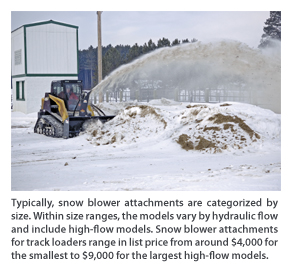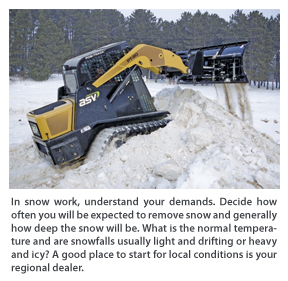Working in a Winter Wonderland

Gone are the days of being slow during the winter months. These days, contractors are not just seeing winter white — but the green of prosperity in the chilly season. With a compact track loader and the right winter-application attachments in their equipment fleet, contractors can work year-round, improving productivity during a season when their machines may have otherwise sat idle, perhaps even moving into new types of applications.
Let It Snow
Compact track loaders (CTL) have become popular machines with contractors working in construction, building, utility services, agriculture, tree farming, vineyards, landscaping and military applications since their introduction to the market in the 1980s. Today, compact track loaders have evolved their applications to work in snow removal and other cold-weather tasks.

The industry has a wide range of CTL choices, models on the market with horsepower ranging from 30 to 100 hp and operating capacities from 560 lb to 2,660 lbs (rated at 35 percent tipping load). The narrow stance of these loaders (48 to 69 in., respectively) offers increased maneuverability when working in confined, snow-packed areas compared to pickups equipped with a snow blade or larger loaders. Furthermore, says Gulbraa, compact track loaders make excellent snow machines because they are specifically engineered to exert low ground pressure, while maintaining exceptional flotation and traction in frozen and snowy ground conditions.
It’s important to look for a compact track loader that is designed with a low center of gravity, giving it exceptional stability on slick terrain. These machines are built to work in extreme temperatures, remaining productive around the clock to keep sidewalks, driveways, cul-de-sacs and parking lots cleared.
Making a Big Impression without Leaving a Mark
Compact track loaders provide many benefits to contractors working in winter weather. The undercarriages of CTLs are designed with multiple contact points provided by the bogie wheels or rollers. Gulbraa explains: “The wheels distribute the weight of the machine over the width and length of the track, decreasing ground pressure and increasing traction.”
To extend the life of the tracks and bogie wheels, Gulbraa recommends that operators working in snowy conditions implement the same operating procedures as when working in mud, including utilizing three-point turns to protect sensitive surfaces and reduce stress to tracks. Operating on level terrain also decreases track wear. When operating on an incline, Gulbraa recommends driving straight up or down. Do not make sudden changes in direction, move slowly and always carry loads low to maximize machine stability.
Some manufacturers offer specialized track options for improving machine performance in the most extreme ground conditions. For example, Terex ASV’s Extreme Terrain Tracks, says Gulbraa, are wider — spreading the machine’s weight over 16.5 in. rather than the standard 15 in. — and feature more aggressive treads that give operators added traction. These tracks are not recommended for use on normal ground conditions, but are ideal for snow applications.
Safety First
No matter what time of year an operator is running a compact track loader, safety must be a top priority.
“Operators should always be familiar with the existing landscaping and infrastructure before they start working,” says Gulbraa. “For example, when using a snow blower attachment, it’s critical to know where the discharged snow will go. It’s equally important that operators are attentive to what other debris may be going into and coming out of the attachment.”

Gulbraa also recommends taking time in colder temperatures to not only warm up the engine, but ensure the hydraulic oil is warmed up as well. Machines need to operate, not just run, for an average of 30 minutes. Heating the hydraulic oil to temperature will ensure optimum response time during operation.
Following the manufacturer’s guidelines for regular maintenance is also important in keeping a compact track loader working safely and efficiently in the winter months. Before start-up, any ice or snow that has accumulated in the tracks and sprockets overnight or while sitting idle should be cleaned out. Next make sure that all fluids are filled to proper levels. Then check that the engine compartment, chassis and coolers are free of debris, windows and lights are clean and tracks are in good condition and properly tensioned. Accessory belts also should be checked for condition and proper tension. Make sure that joysticks and hydraulic auxiliary switches are in neutral positions, and battery cables are properly fastened.
“In cold weather and snow applications, it is good to use common sense when it comes to the compact track loader’s operation,” says Gulbraa. “As the weather conditions change throughout the day, operators should be aware of how the loader is responding. The colder it gets, the more frequent the maintenance checks should be.”
Finally, Gulbraa advises that the loader be properly equipped for cold weather. Options like enclosed cab and heat keep the operator comfortable and productive during long hours in winter applications.
“Using a compact track loader with the right attachments in the winter months,” says Gulbraa, “is a great way to keep your business versatile and create a boost to productivity.”
Amber Reed is a technical writer for Performance Marketing, based in West Des Moines, Iowa.





Comments are closed here.